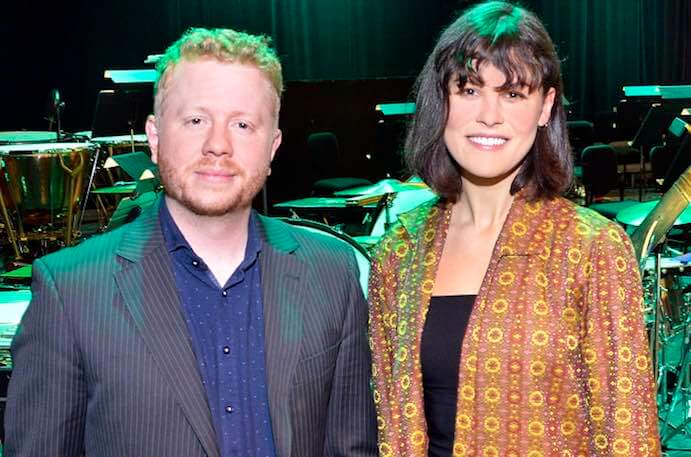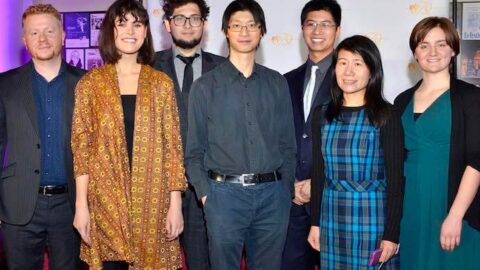The Forks, where the two rivers in Winnipeg meet, is host to one of the longest ice skating trails in the world during the winter months. This local fixture is made even more unique with a series of “warming huts” peppered along the trail to let patrons find reprieve from the elements. These warming huts are small and eccentrically designed: one a transparent orb with 2 wood lawn chairs under tropical scenery, another a large lego-esk buffalo to climb inside, others like giant half not-so-warm kush balls to sit/lay on. These rotating exhibits are indicative of the spirit of the city: constantly looking for new art and culture, especially through the winter months. With such a spirit, it should not be surprising that the Winnipeg New Music Festival also boasts the WNMF Composers Institute, a program designed to mentor promising young Canadian composers in the creation of new works by giving them readings and a performance with the professional orchestra.
The culmination of the Composers Institute on January 30, 2018, in Centennial Concert Hall was a display of well-crafted and innovative ideas, the showcase of which was equally impressive as an institute like this existing with a major orchestra such as the Winnipeg Symphony Orchestra. The success of the numerous world premieres was a strong demonstration of the power of opportunity and training through the Composers Institute.
Whisky Jack, by composer Leslie Opatril, uses the character of the bird by the same name as the impetus for the work. The opening melody is skillfully crafted with an intricate display of offset layers, the composite of which reveals the character of the work; a small, ruffled, flighty bird controls the narrative. The complex layering of material and themes constantly displaced over varying harmonious textures highlights a technical level of prowess untouched by many more prominent composers. The remarkable control of structure to bend and manipulate expectation controlled the narrative of gesture by the imagined bird, keeping the audience enthralled until the final note. In an amazing display of skill and potential, Opatril put herself on display, proving her place on the big stage of the new music world.

Austin Leung put his best foot forward with his new work Prelude. Unabashedly, Prelude features a uniquely still sense of time through sparse and revealing textures. With other composers often building large and vibrant orchestrations, Leung boldly opted for exposed, individual instruments to elegantly place transparent colors into even more fragile layers of sound. The use of the first sound, a major second pitch bend up then down, becomes monumental to the structure. Leung’s focus to create an entire piece seemingly from this moment–which develops into larger pitch bends, timbral shifts, and color changes–is a glimmer into his deft and masterful foresight for structural development.
Monuments, by Steven Webb, is a political commentary, utilizing the concept that all civilizations will fall; Webb goes on to mention the falls we see within societies such as the current attacks on the free press. Monuments’ construction boasted the strongest form of the evening, with clear fragments of material growing and prematurely cut-off. In an impressive feat, Webb’s choices of elements to carry over between each rise and fall were remarkable and certainly played a large role in the success of the work. Even with a heavy hand for orchestration, it is in the subtleties of development and intuition that make Webb stand out.
With a simple three-note motif, Disjunction by Kristen Wachniak does exactly as the title suggests. The innovative development of harmony, color, pitch, and structure from the original motif is set brilliantly to feel related but not in a direct linear fashion. Disjunction is striking and seemingly impulsive in how sounds break from the expected structure. This is not a risk, according to Wachniak, who says she, “[latches] onto one feeling to dance & play with colors and [sees] what fits.” The process is evident, and the fragile colors create dark pastoral landscapes as a base for subtle swells of harmonies that erode the world they belong to. Wachniak uses this work to put not only her superb technical skills on display but also her strong voice that will continue penetrating the new music scene.

Other composers on the program brought their own brands to present to the large WNMF audience. Luis Ramirez brought the amusing and boisterous story of “the coolest guy in the world walking around a noisy city” to life in Chido with well-crafted orchestration and innovative narrative. In Urban Suite, Mv.t II, Chia-Lin Cathy Kuo portrays her personal expression of being an immigrant from Taiwan through a simplistic landscape, taking full use of space and subtle colors, to devise the largest emotive build-up of the night. Black Waltz by Roydon Tse displayed intense fragments of gesture exquisitely layered to create a sound world best described as “if Ives went dancing to the waltz,” showing off impeccable control of structure and orchestration.
Each composer on the concert showed off their skillsets and diverse voices, resulting in a striking array of premieres. The Winnipeg New Music Festival Composers Institute gave these composers a stage on which to show their works to a large audience–for many of the composers the first time. For every composer involved, this performance marked a large step further into the new music world.
























